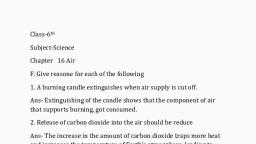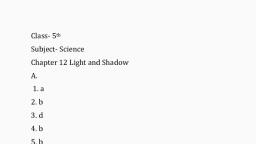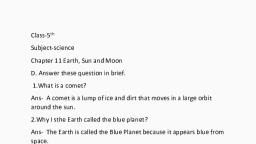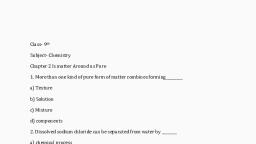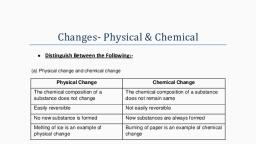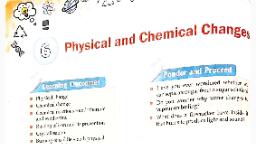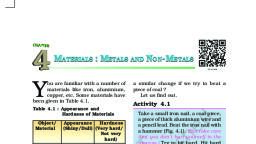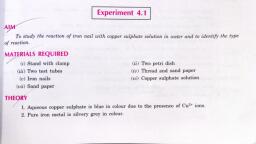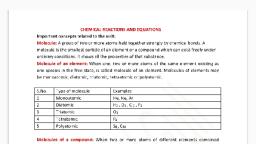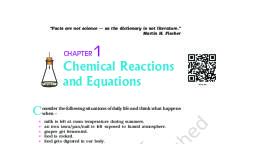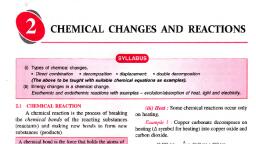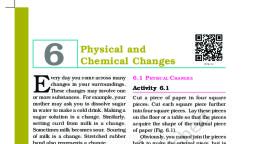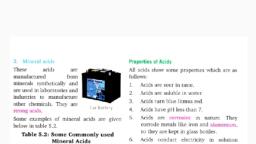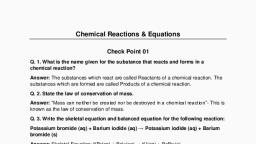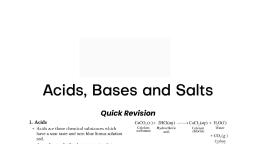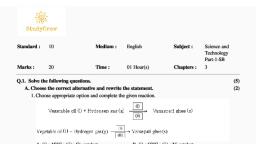Page 1 :
Class-7th, Subject-Science, Chapter 4 Chemicals and chemical Changes, , E. Answer the following question in one word or a sentences, 1.Define a compound, Ans- A pure substance that is formed when two or more elements, combine chemically in a fixed ratio is called a compound., 2.Write the chemical formula of sodium hydroxide, Ans- NaOH, 3. What is precipitate?, Ans- A precipitate is an insoluble compound formed in a reaction, involving solutions., 4. Define atomicity, Ans- Atomicity is the number of atoms present in one molecule of, an element or a compound., 5.Give one example of a reversible physical change, Ans- Melting of ice, F. Answer the following question in brief, 1.Why do cut fruits and vegetables turn brown when exposed to, air?, Ans-Browning is a chemical change in which some compounds in, certain fruits and vegetables react with oxygen in the air to form a, brown-coloured substance called melanin., 2.What is atomicity? State the atomicity of carbon aluminium and, phosphorus.
Page 2 :
Ans- Atomicity is the number of atoms present in one molecule of, an element or a compound. The atomicity of carbon is 2, that of, aluminium is 1 and that of phosphorus is 4., 3.How is salt obtained from sea water, Ans- Salt is obtained from sea water by the process of, crystallization. Sea water contains a large amount of common salt, (sodium chloride) along with other compounds and impurities., Sea water is collected in large open pits called salt pans. The, water collected in the salt pans evaporates due to sun’s heat,, leaving behind the solid salt. This impure salt is purified by the, process of crystallization., 4.What is rusting? Write the chemical formula of rust. Write one, method to prevent or iron, Ans- Iron objects develop a reddish-brown powdery or flaky, substance on their surface. This substance is called rust. The, chemical name of rust is iron oxide. It is formed when iron is, exposed to moisture (water vapour) and oxygen in the air., Therefore, rusting is a chemical change in which iron reacts with, water and oxygen to form iron oxide or rust., 5. What happen when vinegar and baking soda are mixed, together., Ans- Vinegar and baking soda react to form bubbles of carbon, dioxide gas, sodium acetate and water., G. Answer the following question in details, 1.Differentiate between elements, compound and mixture, Ans- Elements: A pure substance that is made up of only one kind, of atom and cannot be broken into simpler substances is called an, element. Aluminium, copper, iron, calcium, oxygen, carbon,, nitrogen, sulphur and mercury are examples.
Page 3 :
Compounds: A pure substance that is formed when two or more, elements combine chemically in a fixed ratio is called a, compound. Water, carbon dioxide, sodium chloride (common, salt) and iron sulphide are examples of compounds., Mixtures: An impure substance formed when two or more, substances are physically mixed together in any ratio is called a, mixture. Sugar solution, salt solution and air are examples of, mixtures., 2. What are physical change? Explain the characteristics of, physical change with relevant examples., Ans- The changes in which no new substances are formed are, called physical changes. These changes occur only due to changes, in physical properties of a substance, such as change in shape, size, and state. Melting of wax, formation of steam, breaking of glass, and tearing of paper are a few examples of physical changes., 3. Define crystallization and describe how it is carried in the, laboratory., Ans- Crystallization is a method by which a solid dissolved in a, liquid is separated from it in the form of crystals., Procedure of crystallization in a laboratory is as follows:, i., , ii., , iii., iv., , Take about 100 ml of water in a beaker. Dissolve sugar in, the water till you make a saturated solution. Boil this, solution on a burner., ii. To the boiling solution, add some more sugar (in small, lots) while stirring till no more sugar dissolves in the, solution., Carefully filter the hot solution to remove the sugar (that, remains undissolved) and insoluble impurities, Take a thick cotton thread and tie it in the middle of the, glass rod. Place the glass rod on the mouth of the beaker in, such a way that the thread is dipped in the sugar solution.
Page 4 :
v., , Leave the solution undisturbed for two hours and allow it, to cool., Observation: Sugar crystals are formed over the thread., Conclusion: As the supersaturated solution cools down, the, sugar particles present in it starts separating out. These, sugar particles aggregate in definite geometrical shapes, forming crystals., , 4. Explain the different characteristics of chemical change with, examples, Ans- Characteristics of chemical changes: Change in colour: A, change in colour may indicate that a product has formed that is, different from the reactants., For example, when an iron nail is immersed in a blue solution of, copper sulphate, the solution turns green., Formation of a gas: In some chemical changes, a gas is formed as, a product and is released as effervescence. Common chemical, reactions with effervescence usually release either carbon, dioxide, hydrogen or ammonia. For example, when zinc granules, are added to hydrochloric acid, bubbles of hydrogen gas are, formed., Evolution or absorption of heat: A chemical change may cause the, evolution or absorption of heat, thus changing the temperature of, the reaction mixture. For example, carbon reacts with oxygen to, form carbon dioxide and heat., Formation of precipitate: A precipitate is an insoluble compound, formed in a reaction involving solutions. For example, when, colourless solutions of lead nitrate and potassium iodide are, mixed, a yellow precipitate is formed., Emission of light, sound or smell: Some reactions may involve the, emission of light. Burning is a chemical change that usually
Page 5 :
involves the emission of heat and light. For example, a magnesium, ribbon burns in oxygen with a dazzling white light., 5. Prove with an experiment that both air moisture are necessary, for rusting of iron .Draw supporting diagram., Ans- Aim: To show that both oxygen and water are required for, rusting of iron, Materials required:, Three test tubes, test tube stand, three iron nails, water, oil, corks, and anhydrous calcium chloride, Procedure:, i., ii., iii., , iv., , v., , Place three clean test tubes on a test tube stand and label, them A, B and C., In test tube A, pour some tap water and place a clean, iron nail in it. Cork the test tube., In Test tube B, pour some boiled distilled water. Place a, clean iron nail in the test tube. Pour some vegetable oil in, the test tube to cut off the air contact and cork it., In test tube C, put some anhydrous calcium chloride to, absorb the moisture present in it. Place a clean iron nail, and cork the test tube., Leave the test tubes undisturbed for 4 days. Observe, what happens after 4 days., Observations: Iron nail kept in test tube A rusts, while, irons nails kept in test tubes B and C do not rust., Conclusion: In test tube A, both air and moisture are, present, while in test tube B there is no air. In test tube C,, moisture is absent. Rusting of iron nail kept in test tube A, proves that both air and moisture are necessary for
Page 6 :
rusting of iron. Air A B C Oil Water Rusted nail Tube A, Tube B Tube C Anhydrous CaCl2 Dry air Boiled water H. 1., Students should write about the chemical change and the, involvement of heat to produce new products. 2. Students, should be able to justify their answer whether they say, yes or no. I. The pan is coated black. It is a physical, change. The wood is burning. It is a chemical change. The, egg is broken, which is a physical change. When cooked, it, is a chemical change., Draw diagram from textbook page no. 61
